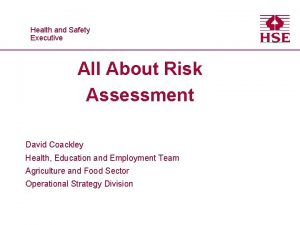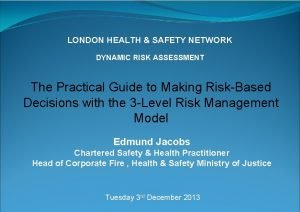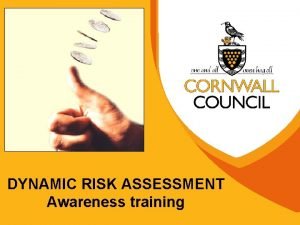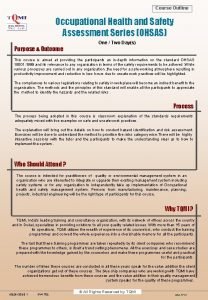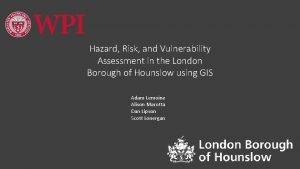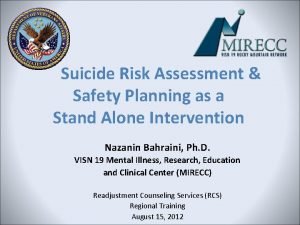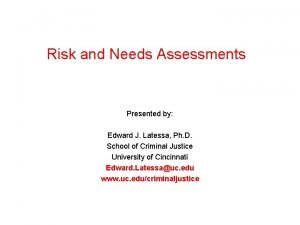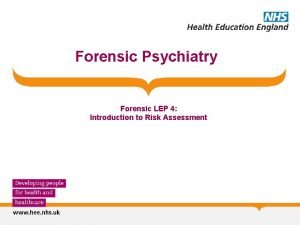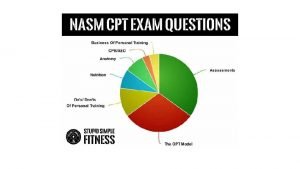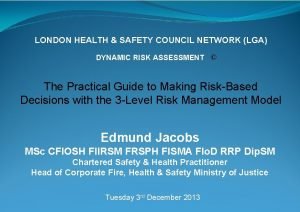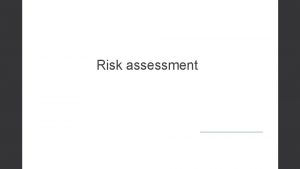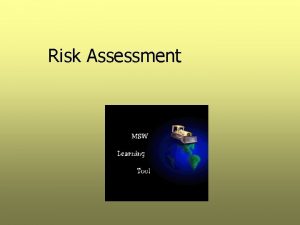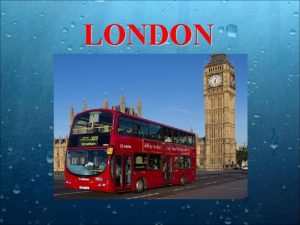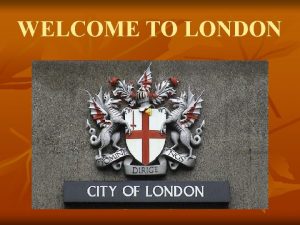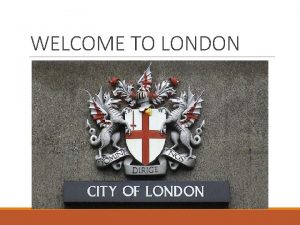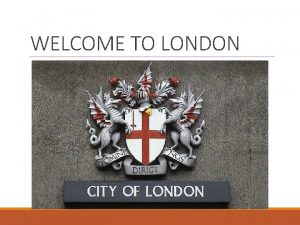LONDON HEALTH SAFETY NETWORK DYNAMIC RISK ASSESSMENT The
















- Slides: 16

LONDON HEALTH & SAFETY NETWORK DYNAMIC RISK ASSESSMENT The Practical Guide to Making Risk-Based Decisions with the 3 -Level Risk Management Model Edmund Jacobs Chartered Safety & Health Practitioner Head of Corporate Fire , Health & Safety Ministry of Justice Tuesday 3 rd December 2013

Emergence of dynamic risk assessment (DRA) • Historically the Fire Service carried out situation awareness and assessment referred to as “size-up”. • The HSE served a number of Improvement Notices following a number of fire-fighter fatalities. • The fire service introduced the new concept of DRA in the early 1990’s as a means to manage operational risk in dynamic situations. • The need for rapid assessments in dynamic situations has led to an increase in organisations adopting DRA methodology.

How is DRA defined? Historical LFEPA dynamic risk assessment definition “the continuous assessment of risk in the rapidly changing circumstances of an operational incident, in order to implement the control measures necessary to ensure an acceptable level of safety”. (HM Fire Service Inspectorate, 1998)

Dynamic Risk Assessment Concepts • DRA is concerned with on the spot decision-making. • Link between risk and decision-making resulting in a raised awareness of cognitive processes involved in assessing risk. • There needs to be a strong basis of risk assessment and a risk management structure in which the assessment of risk in dynamic situations may exist. • Recognition that some organisations operate in: - high risk / pressurised - unpredictable / shifting and competing goals - rapidly changing (dynamic) situations requiring continual assessment.

5 Step Process of assessing risk in dynamic situations Step 1: Evaluate situation/activity and person's at risk Step 2: Select a system of work Step 3: Assess the chosen system of work is safe? (consider risk v benefit) If appropriate proceed Step 4: If not, introduce additional controls or select another system of work (if available) Step 5: Re-assess systems of work, introduce further controls if required/possible

Misconceptions and Myths • DRA is just an alternative to activity based risk assessment • My staff do DRA, so I’m covered! • It’s a tick box (back covering) exercise and we do it all the time anyway! • DRA is dealing with dynamic risk • I’ve done a DRA and I’m not going to do my job because it’s too risky!

CASE STUDY Cornish Glennroy Blair-Ford v CRS Adventures Limited Some of the issues considered • Were formal Health & Safety management systems in place? • Were formal risk assessments in place for Mini-Olympics as a whole? • Was there an assessment of risk before the specific activity? • Company safety record • Was the activity dynamic in nature and the risk foreseeable? • Were staff suitably trained in risk assessment and job role? • Previously known incidents/risks associated with the event

Summary of Judge’s conclusion: • Had a formal risk assessment for Mini-Olympics as a whole • Good safety record (no other incidents involving welly-wanging) • Specific risk assessment not required due to unforeseeable risk • Judge satisfied that a DRA was acceptable (due to variable factors involved, e. g. uneven ground, unusual throwing) • Based on a DRA, no steps needed to modify the method or to provide any specific warnings • Claim dismissed, with judgement entered for the defendant

As an employer what expectations do you place on staff to deal with situations that are dynamic? • How do you ensure SFARP that your staff present the appropriate behavioural responses in these dynamic situations? • Do you have suitable and sufficient risk assessments in place for predictable risks? • How do you prepare prior and during the event or activity and what is your contingency if it goes wrong? • Is your risk management process sensible and proportionate? • Is OHS working in partnership with operational risk, strategic risk and business risk management?

How can organisations effectively integrate DRA methodology into their risk management processes?

Core Values • Good consistent behaviour cannot be assured without assuring core values. • Core values must be well understood by the entire organisation. • Historical Fire & Rescue Services core values: “We may risk our lives a lot, in a highly calculated manner, to protect saveable lives. We may risk our lives a little, in a highly controlled manner, to protect saveable property. We will not risk our lives at all for lives or property that are already lost. ” (HM Fire Inspectorate, 1998) • Staff need to know what is expected of them and how to act when facing any dynamic situation. • Recognition of DRA through senior management buy-in.

Three Levels of Risk Management Model STRATEGIC RISK ASSESSMENT PREDICTIVE RISK ASSESSMENT DYNAMIC RISK ASSESSMENT

Safe Person Concept – (Employer critical support issues) Personal Protective Equipment Training Information Specialist Equipment Instruction Selection Supervision Safe Systems of Work

Safe Person Concept – Employee responsibilities Vigilant for his/her own safety, colleagues & others Adaptable to changing circumstances Able to recognise his/her abilities and limitations Self-disciplined to work within accepted systems of work Competent to perform tasks assigned An effective member of a team

Debrief, Feedback and Learning • Provides the basis for learning in a systematic way from activities. • Communication, dissemination and feedback of information has a key role. • Line Management should review risk assessment as an integral part of the process. • How do you ensure that you have relevant records before, during and after the activity? • How do you ensure that there is effective decision evaluation and can this be evidenced, if called upon?

Thank you for listening Any questions?
 Health and safety risk assessment template
Health and safety risk assessment template Health safety
Health safety Dynamic risk assessment
Dynamic risk assessment Credit risk market risk operational risk
Credit risk market risk operational risk Define dynamic assessment
Define dynamic assessment Ind safety report
Ind safety report Population health risk assessment and management
Population health risk assessment and management Occupational health and safety course outline
Occupational health and safety course outline Comah
Comah Transferered
Transferered South west london health and care partnership
South west london health and care partnership Dynamic risk factors
Dynamic risk factors Dynamic risk factors
Dynamic risk factors 5ps formulation
5ps formulation Types of dynamic assessment
Types of dynamic assessment Postural assessment
Postural assessment Postural distortion syndrome
Postural distortion syndrome
